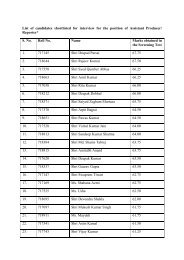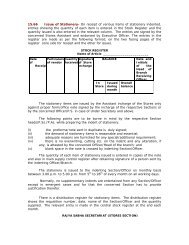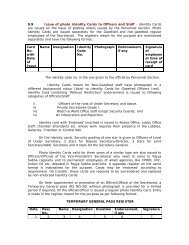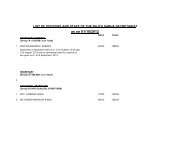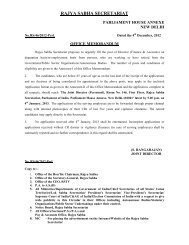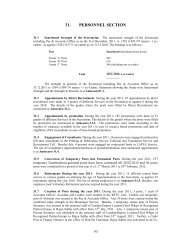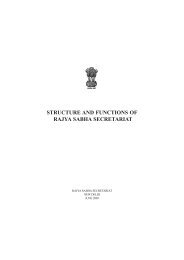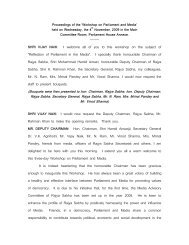RAJYA SABHA â THE UPPER HOUSE OF INDIAN PARLIAMENT
RAJYA SABHA â THE UPPER HOUSE OF INDIAN PARLIAMENT
RAJYA SABHA â THE UPPER HOUSE OF INDIAN PARLIAMENT
Create successful ePaper yourself
Turn your PDF publications into a flip-book with our unique Google optimized e-Paper software.
<strong>RAJYA</strong> <strong>SABHA</strong> —<br />
<strong>THE</strong> <strong>UPPER</strong> <strong>HOUSE</strong> <strong>OF</strong> <strong>INDIAN</strong><br />
<strong>PARLIAMENT</strong><br />
F. No. RS. 17/5/2005-R & L<br />
© <strong>RAJYA</strong> <strong>SABHA</strong> SECRETARIAT, NEW DELHI<br />
http://parliamentofindia.nic.in<br />
http://rajyasabha.nic.in<br />
E-mail: rsrlib@sansad.nic.in<br />
<strong>RAJYA</strong> <strong>SABHA</strong> SECRETARIAT<br />
NEW DELHI<br />
PUBLISHED BY SECRETARY-GENERAL, <strong>RAJYA</strong> <strong>SABHA</strong> AND<br />
PRINTED BY MANAGER, GOVERNMENT <strong>OF</strong> INDIA PRESS,<br />
MINTO ROAD, NEW DELHI-110002.
P R E F A C E<br />
This booklet is part of the Rajya Sabha Practice and<br />
Procedure Series which seeks to describe briefly the<br />
functioning of Rajya Sabha, one of the two Houses of<br />
the Indian Parliament. Information contained in the<br />
booklet is not exhaustive. For full and authentic<br />
information, original sources such as the Constitution<br />
of India, the Rules of Procedure and Conduct of<br />
Business in Rajya Sabha, etc. may be referred to and<br />
relied upon.<br />
New Delhi<br />
February, 2005<br />
DR. YOGENDRA NARAIN<br />
Secretary-General
<strong>RAJYA</strong> <strong>SABHA</strong>—<strong>THE</strong> <strong>UPPER</strong> <strong>HOUSE</strong> <strong>OF</strong> <strong>INDIAN</strong><br />
<strong>PARLIAMENT</strong><br />
Growth of Bicameralism<br />
In India, a Second Chamber was envisaged for the<br />
first time under the Montague Chelmsford Reforms<br />
proposals. The Government of India Act, 1919<br />
accordingly, provided that the Indian Legislature shall<br />
consist of the Governor-General and the two<br />
chambers, namely the Council of State and the House<br />
of Assembly. The term of the Council was fixed at five<br />
years. Under the Government of India Act, 1935,<br />
however, the Council of State was made a continuous<br />
body, not subject to dissolution. The members were<br />
to hold their seats for nine years and one-third of them<br />
retiring at the end of every three years. But the scheme<br />
envisaged for the Second Chamber under the<br />
Government of India Act, 1935, never materialised<br />
because the provisions pertaining to the federal<br />
structure under the Act were never put into operation.<br />
As a result, the Second Chamber set up under the<br />
Government of India Act, 1919 continued to function<br />
till 1947.<br />
Composition of Parliament<br />
Parliament of India consists of the President and two<br />
Houses—the Council of States (Rajya Sabha) and the<br />
1<br />
House of the People (Lok Sabha)*. Rajya Sabha, as its<br />
name suggests, represents the States although the<br />
States are not equally represented in this House.<br />
Rajya Sabha consists of the representatives of the<br />
States and the Union territories and persons nominated<br />
by the President of India. Not more than two hundred<br />
and thirty-eight representatives of the States and the<br />
Union territories can be elected to Rajya Sabha. The<br />
allocation of seats to the States and the Union territories<br />
has broadly been made on the basis of population and<br />
the number of seats to be filled up by each of them has<br />
been specified in the Fourth Schedule to the<br />
Constitution.<br />
The representatives of the States are elected by their<br />
respective Legislative Assemblies in accordance with<br />
the system of proportional representation by means of<br />
the single transferable vote and Parliament by law<br />
prescribes the mode of choosing the representatives of<br />
the Union territories.<br />
*The first sitting of the Council of States, under the Constitution,<br />
was held on 13 May 1952. On 14 May 1954, the Speaker, Lok<br />
Sabha, Shri G.V. Mavalankar, announced that the House of the<br />
People would thereafter be known as ‘Lok Sabha’. On 23 August<br />
1954, the Chairman of the Council of States, Dr. S. Radhakrishnan<br />
made a similar announcement that the Council of States would be<br />
called ‘Rajya Sabha’. The terms ‘Lok Sabha’ and ‘Rajya Sabha’<br />
were, in fact, used for the first time in an amendment to the Delhi<br />
(Control of Building Operations) Bill, 1955.<br />
2
Apart from elected members, Rajya Sabha has twelve<br />
members nominated by the President of India from<br />
amongst persons having special knowledge or practical<br />
experience in respect of such matters as literature,<br />
science, art and social service.<br />
The present strength of Rajya Sabha is 245.<br />
Duration<br />
As per the provisions of the Constitution, Rajya Sabha<br />
is not subject to dissolution but one-third of its members<br />
retire every second year. The term of individual members<br />
is six years. Casual vacancies whenever occurring, are<br />
filled through bye-elections for the remaining term only.<br />
Qualification for Membership<br />
In order to be chosen a member of Rajya Sabha, a<br />
person (a) must be a citizen of India, (b) must not be<br />
less than 30 years of age. Under the Representation of<br />
the People Act, 1951, a person had to be an elector in a<br />
parliamentary constituency in the State from where he<br />
seeks election to Rajya Sabha. It may, however, be<br />
mentioned that the Representation of the People<br />
(Amendment) Act, 2003, which amended Section 3 of<br />
the Representation of the People Act, 1951, has done<br />
away with the requirement of being a resident of State<br />
or Union territory from which a person seeks to contest<br />
elections to Rajya Sabha. He/She has to be an elector<br />
in a parliamentary constituency anywhere in India. It<br />
3<br />
has also provided that the election to fill a seat in Rajya<br />
Sabha shall be by open ballot.<br />
Disqualification for Membership<br />
The following grounds could disqualify a person for<br />
being chosen and for being a member of Rajya Sabha—<br />
(a) if he holds any office of profit under the<br />
Government of India or the Government of any<br />
State, other than an office declared by Parliament,<br />
by law, not to disqualify its holder;<br />
(b) if he is of unsound mind and stands so declared<br />
by a competent court;<br />
(c) if he is an undischarged insolvent;<br />
(d) if he is not a citizen of India, or has voluntarily<br />
acquired the citizenship of a foreign State, or is<br />
under any acknowledgement of allegiance or<br />
adherence to a foreign State; and<br />
(e) if he is so disqualified by or under any law made<br />
by Parliament.<br />
The mere fact of a person being a Minister either of<br />
the Union or of any State does not amount to holding an<br />
office of profit. Pursuant to certain constitutional<br />
provisions, Parliament has enacted laws exempting<br />
holders of certain offices from being disqualified as<br />
members of Parliament.<br />
4
The President of India is the final authority to decide<br />
if a member has become subject to any of the<br />
disqualifications. Before giving his decision, however,<br />
the President obtains the opinion of the Election<br />
Commission of India and acts according to such<br />
opinion.<br />
Besides, the Constitution provides for disqualification<br />
of the members on ground of defection. As per the<br />
provisions contained in the Tenth Schedule to the<br />
Constitution a person shall be disqualified for being a<br />
member :<br />
(i) if he has voluntarily given up the membership of<br />
his political party; and<br />
(ii) if he votes or abstains from voting in the House<br />
contrary to any direction issued by the political<br />
party to which he belongs, unless such voting or<br />
abstention has been condoned by the political<br />
party within fifteen days.<br />
An elected member who has been returned to the<br />
House as an Independent candidate shall incur<br />
disqualification if he joins any political party after such<br />
election.<br />
A nominated member of the House shall be<br />
disqualified from the membership of the House if he joins<br />
any political party after the expiry of six months from<br />
the date of his taking seat in the House.<br />
5<br />
However, disqualification on ground of defection does<br />
not apply in case of merger of political parties under the<br />
provisions contained in the Tenth Schedule to the<br />
Constitution. It may be mentioned that the Constitution<br />
(Ninety-first Amendment) Act, 2003 sought, inter alia,<br />
an amendment to the Tenth Schedule by omitting<br />
paragraph 3 pertaining to the exemption from<br />
disqualification in case of split in a legislature party.<br />
The provisions of disqualification, under the Tenth<br />
Schedule, do not apply to a member who on his election<br />
as the Speaker or the Deputy Speaker of Lok Sabha or<br />
the Deputy Chairman of Rajya Sabha, or the Chairman<br />
or the Deputy Chairman of the Legislative Council of a<br />
State or the Speaker or the Deputy Speaker of the<br />
Legislative Assembly voluntarily gives up his membership<br />
of the political party to which he belonged immediately<br />
before his election or rejoins such political party after<br />
he ceases to hold such office.<br />
The Chairman or, as the case may be, the Speaker<br />
has been given the final authority to decide questions of<br />
disqualification of a member of a House under the<br />
provisions of the Tenth Schedule to the Constitution.<br />
Presiding Officers of Rajya Sabha<br />
Chairman<br />
The Vice-President of India is ex-officio Chairman of<br />
Rajya Sabha. While the office of the Chairman is vacant,<br />
6
or during any period when he acts or discharges the<br />
functions of President, the Deputy Chairman of Rajya<br />
Sabha performs the duties of the office of the Chairman.<br />
If the office of the Deputy Chairman is also vacant, the<br />
President appoints a member of the House to perform<br />
the duties of the office.<br />
The Chairman presides over Rajya Sabha and<br />
regulates its proceedings. He maintains order in the<br />
House. He also has the power to adjourn Rajya Sabha<br />
and suspend its meeting if there is no quorum. He is<br />
the channel of communication between the House and<br />
any other outside person or authority. He has to decide<br />
under constitutional provisions whether a member of<br />
Rajya Sabha has tendered his resignation voluntarily.<br />
He has also to decide under the constitutional provisions,<br />
question of disqualification on grounds of defection. Under<br />
the Rules of Procedure and Conduct of Business in<br />
Rajya Sabha, the Chairman admits notices of Questions,<br />
Motions, Resolutions, etc.<br />
While presiding over Rajya Sabha, the Chairman has<br />
only a casting vote. When a resolution for his removal is<br />
under consideration he is neither entitled to preside over<br />
the House nor to vote on such a resolution but has a right<br />
to speak in or otherwise to take part in such proceedings.<br />
Deputy Chairman<br />
Rajya Sabha elects a Deputy Chairman to perform<br />
the functions of the Chairman in case of a vacancy in<br />
7<br />
the office of the Chairman or when the Vice-President<br />
is acting as or discharging the functions of the<br />
President. He may be removed from office by a<br />
resolution of Rajya Sabha moved after fourteen days<br />
notice of the intention to move the resolution and<br />
passed by a majority of all the then members of the<br />
House.<br />
Panel of Vice-Chairmen<br />
There is also a panel of six Vice-Chairmen formed by<br />
the Chairman, and in case both the Chairman and the<br />
Deputy Chairman are absent, a person from the panel<br />
presides. If none of the empanelled members is available,<br />
the House elects a person from amongst its members<br />
to preside over its sittings.<br />
Quorum<br />
One tenth of the total number of members of Rajya<br />
Sabha constitutes the quorum for a meeting of the<br />
House.<br />
Voting<br />
All questions are decided by majority vote. The<br />
Chairman or person acting as such, has no vote in the<br />
first instance, but has a casting vote in the case of an<br />
equality of votes. A Minister is entitled to vote only if he<br />
is a member of the House.<br />
8
Powers, Privileges and Immunities of the House<br />
and Members<br />
Parliamentary privileges in India are not codified.<br />
Some of the privileges and immunities of the Houses of<br />
Parliament, the members and committees thereof are<br />
specified in the Constitution, certain statutes and the<br />
Rules of Procedure of the Houses, while others continue<br />
to be based on precedents of the British House of<br />
Commons, and on conventions which have grown over<br />
the years.<br />
A few important privileges and immunities are :<br />
(i) Freedom of speech in Parliament and immunity<br />
of a member from any proceedings in any court<br />
in respect of anything said or any vote given by<br />
him in Parliament or any committee thereof.<br />
(ii) Immunity to a person from proceedings in any<br />
court in respect of the publication by or under the<br />
authority of either House of Parliament of any<br />
report, paper, votes or proceedings.<br />
(iii) Prohibition on the courts to inquire into<br />
proceedings of Parliament.<br />
(iv) Immunity to a person from any court proceedings<br />
in respect of the publication in newspaper of a<br />
substantially true report of any proceedings of<br />
either House of Parliament unless the publication<br />
is proved to have been made with malice.<br />
9<br />
(v) Freedom from arrest of members in civil cases<br />
during the continuance of the session of the<br />
House and forty days before the commencement<br />
and forty days after its conclusion.<br />
(vi) Exemption of a member from service of legal<br />
process and arrest within the precincts of the<br />
House.<br />
Functions<br />
The functions of Rajya Sabha may broadly be<br />
categorised as : Legislative, Financial, Deliberative and<br />
Federal. Legislation is by far the most important business<br />
of Rajya Sabha, as indeed of Parliament and in this<br />
sphere, Rajya Sabha enjoys almost equal powers with<br />
Lok Sabha.<br />
Legislative Functions<br />
The Constitution has classified the subjects for<br />
legislation into three Lists, namely (1) the Union List,<br />
(2) the State List and (3) the Concurrent List. The Union<br />
List includes those subjects over which Parliament has<br />
exclusive authority to make laws, while the Concurrent<br />
List enumerates those subjects over which it has<br />
authority along with the States. It has been provided<br />
that if the Legislature of a State makes a law in respect<br />
of a matter enumerated in the Concurrent List which<br />
contains any provision repugnant to the provisions of a<br />
law made by Parliament with respect to that matter,<br />
10
then the law so made by the Legislature of such State<br />
will, if it has been reserved for the consideration of the<br />
President and has received his assent, prevail in that<br />
State but at the same time Parliament has the power to<br />
enact any law with respect to the same matter including<br />
a law adding to, amending, varying or repealing the law<br />
so made by the Legislature of the State. The residuary<br />
power is vested in the Centre.<br />
Even in regard to the State List, over which the States<br />
have exclusive jurisdiction, Parliament can assume<br />
authority, if (1) Rajya Sabha declares by a resolution<br />
supported by not less than two-thirds of the members<br />
present and voting that such legislation is in national<br />
interest, or (2) two or more States mutually agree that<br />
Parliament may do so, or (3) it is necessary to<br />
implement treaties or international conventions. Further,<br />
when a Proclamation of Emergency is in operation,<br />
Parliament is competent to legislate on matters included<br />
in the State List.<br />
A Bill can be introduced in either House of Parliament.<br />
A Bill introduced by the Minister is known as Government<br />
Bill and a Bill introduced by a private member is known<br />
as Private Member’s Bill. The procedure for the passage<br />
of the Bills is similar in both the cases.<br />
A Bill has to pass through three stages in each House<br />
of Parliament and receive Presidential assent before it<br />
becomes an Act of Parliament.<br />
11<br />
In the event of a deadlock between the two Houses<br />
on a Bill other than a Money Bill or a Constitution<br />
Amendment Bill, the issue is resolved at a joint sitting<br />
of the two Houses.<br />
Financial Functions<br />
Under the Constitution, financial legislation has been<br />
divided into two categories - Money Bills and Financial<br />
Bills. The former contains only and exclusively money<br />
clauses and the latter, apart from money clauses also<br />
contains other matters. Neither type of Bill can be<br />
introduced in Rajya Sabha. A Bill which, if enacted and<br />
brought into operation would involve expenditure from<br />
the Consolidated Fund of India is also called a Financial<br />
Bill. Such a Bill, however, can be introduced in Rajya<br />
Sabha. It cannot be passed by either House of<br />
Parliament unless the President has recommended to<br />
that House the consideration of the Bill. With respect to<br />
Money Bills, Rajya Sabha is empowered to make only<br />
recommendations. If a Money Bill which is transmitted<br />
to Rajya Sabha for its recommendations is not returned<br />
to Lok Sabha within fourteen days, it is deemed to have<br />
been passed by both Houses at the expiration of the<br />
said period in the form it was passed by Lok Sabha.<br />
However, in case of Financial Bills, Rajya Sabha has<br />
full powers like an ordinary piece of legislation.<br />
The Annual Budget of the Government in laid before<br />
Rajya Sabha also, although the Budget speech is made<br />
12
in Lok Sabha only. Rajya Sabha has no powers to vote<br />
on the Demands for Grants of the Ministries/Departments<br />
which is the exclusive domain of Lok Sabha. However,<br />
the twenty-four Department-related Parliamentary<br />
Standing Committees which have thirty-one members,<br />
ten from Rajya Sabha and twenty-one from Lok Sabha,<br />
examine the Demands for Grants of the respective<br />
Ministries/Departments of the Government of India.<br />
Deliberative Functions<br />
One of the important functions of Rajya Sabha is to<br />
focus public attention on major problems affecting<br />
policies of the Government and administration and to<br />
provide a forum for ventilation of public grievances. This<br />
responsibility is discharged through deliberations on<br />
General Budget, Railway Budget, Motion of Thanks on<br />
the President’s Address, Five-Year Plans and working<br />
of various Ministries/Departments and on various policy<br />
statements made by the Government. Rajya Sabha also<br />
places its views on various international issues.<br />
Federal Functions<br />
Rajya Sabha enjoys certain special powers under<br />
the Constitution. Rajya Sabha may pass a resolution,<br />
by a majority of not less than two-thirds of the members<br />
present and voting, to the effect that it is necessary or<br />
expedient in the national interest that Parliament should<br />
make a law with respect to any matter enumerated in<br />
the State List. Then, Parliament becomes empowered<br />
13<br />
to make a law on the subject specified in the resolution<br />
for the whole or any part of the territory of India. Such a<br />
resolution remains in force for a maximum period of one<br />
year but this period can be extended by one year at a<br />
time by passing a further resolution.<br />
If Rajya Sabha passes a resolution by a majority of<br />
not less than two-thirds of the members present and<br />
voting declaring that it is necessary or expedient in the<br />
national interest to create one or more All India Services<br />
common to the Union and the States, Parliament may<br />
then by law provide for the creation of such service or<br />
services.<br />
Under the Constitution, the President is empowered<br />
to issue Proclamations in the event of national<br />
emergency, in the event of failure of constitutional<br />
machinery in a State, or in the case of financial<br />
emergency. Normally, every such Proclamation has to<br />
be approved by both Houses of Parliament within a<br />
stipulated period. Under certain circumstances, however,<br />
Rajya Sabha enjoys special powers in this regard. If a<br />
Proclamation is issued at a time when Lok Sabha has<br />
been dissolved or the dissolution of Lok Sabha takes<br />
place within the period allowed for its approval, then the<br />
Proclamation can remain effective if, a resolution<br />
approving it is passed by Rajya Sabha.<br />
The committee system in Rajya Sabha<br />
Parliamentary Committees are of two types - ad hoc<br />
14
Committees and Standing Committees. An ad hoc<br />
Committee is created for a specific purpose and when it<br />
has completed its assigned task and has submitted its<br />
report, it becomes functus officio. Commonly known<br />
examples of such ad hoc committees are the Select<br />
and joint Committees on Bills.<br />
Rajya Sabha has the following Standing Committees,<br />
members of which are nominated by the Chairman of<br />
Rajya Sabha.<br />
Committee of Privileges : It examines questions<br />
involving breach of privileges of the House or of the<br />
members or any of its committees referred to it by the<br />
House or by the Chairman.<br />
Committee on Petitions: It examines petitions on Bills<br />
and matters of general public interest and also entertains<br />
representations on matters concerning central subjects.<br />
Committee on Government Assurances: It scrutinises<br />
the assurances given by Ministers in the House and<br />
reports to the House regarding their implementation.<br />
Committee on Subordinate Legislation: It scrutinises<br />
and reports to the House whether the powers to make<br />
regulations, rules, sub-rules, bye-laws, etc., conferred<br />
by the Constitution or Acts, are being properly exercised<br />
by the Executive within the scope of such delegation.<br />
Committee on Papers Laid on the Table: It examines<br />
the Papers laid on the Table of the House by Ministers<br />
15<br />
to see whether there has been compliance of the<br />
provisions of the Constitution, Act, rules or regulations<br />
under which the Paper has been laid.<br />
Business Advisory Committee: It recommends the<br />
time that should be allotted for discussion of legislative<br />
and other business which is to be brought before the<br />
House.<br />
Rules Committee: It considers matters of procedure<br />
and conduct of business in the House and recommends<br />
amendments to the rules that are considered<br />
necessary.<br />
General Purposes Committee: It considers and<br />
advises the Chairman on matters concerning the affairs<br />
of the House, which do not appropriately fall within the<br />
purview of any other committee.<br />
House Committee: It deals with the residential<br />
accommodation and other amenities for members.<br />
Committee on Ethics: It oversees the ethical and<br />
moral conduct of the members of Rajya Sabha and also<br />
examines cases referred to it with reference to ethical<br />
and other misconduct of members.<br />
Committee on Provision of Computers to Members<br />
of Rajya Sabha: It deals with matters relating to supply<br />
of computers to members and also reviews the hardware<br />
and software requirements of members.<br />
16
Committee on Members of Parliament Local Area<br />
Development Scheme : This Committee monitors the<br />
implementation of the Member of Parliament Local Area<br />
Development (MPLAD) Scheme.<br />
Members of Rajya Sabha are also associated with<br />
some of the important Committees of Lok Sabha like<br />
the Committee on Public Accounts, Commtitee on Public<br />
Undertakings and Committee on the Welfare of<br />
Scheduled Castes and Scheduled Tribes.<br />
Department-related Parliamentary Standing<br />
Committees<br />
With a view to further strengthening the Committee<br />
System, the two Houses of Parliament gave unanimous<br />
approval on 29 March 1993, for the setting up of the<br />
seventeen Department-related Standing Committees.<br />
The Department-related Parliamentary Committee<br />
System was inaugurated on 31 March 1993 and the<br />
new Committees started functioning from 8 April 1993.<br />
Members of both Houses serve on these Committees .<br />
Six of the seventeen Department related Parliamentary<br />
Standing Committees set up initially, viz., the Committee<br />
on Commerce; the Committee on Home Affairs; the<br />
Committee on Human Resource Development; the<br />
Committee on Industry; the Committee on Science and<br />
Technology, Environment and Forests; and the<br />
Committee on Transport, Tourism and Culture are under<br />
the administrative control of the Chairman of Rajya Sabha.<br />
It may be mentioned that in July 2004, the number of<br />
17<br />
these Committees has been increased to twenty four<br />
with a view to streamlining the committee system and<br />
broadening the Parliamentary scrutiny of the executive.<br />
Out of these twenty four committees, eight function<br />
under the control and direction of the Chairman, Rajya<br />
Sabha. The two new Committees which function under<br />
the administrative control of Chairman of Rajya Sabha<br />
are the Committee on Health and Family Welfare, and<br />
the Committee on Personnel, Public Grievances, Law<br />
and Justice.<br />
These Committees encompass for scrutiny purpose<br />
all Ministries and Departments of the Government within<br />
their ambit. The Department-related Committees are<br />
entrusted with the following functions :<br />
(a) to consider the Demands for Grants of the related<br />
Ministries/Departments and report thereon. The<br />
report shall not suggest anything of the nature of<br />
cut motions;<br />
(b) to examine Bills, pertaining to the related<br />
Ministries/Departments, referred to the Committee<br />
by the Chairman or the Speaker, as the case may<br />
be, and report thereon;<br />
(c) to consider the annual reports of the Ministries/<br />
Departments and report thereon; and<br />
(d) to consider national basic long term policy<br />
documents presented to the Houses, if referred<br />
to the Committee by the Chairman or the Speaker,<br />
as the case may be, and report thereon.<br />
18
These Standing Committees are not to consider<br />
matters of day-to-day administration of the related<br />
Ministries/Departments.<br />
Secretary-General and the Secretariat<br />
Rajya Sabha has a Secretariat of its own headed by<br />
the Secretary-General, who is a permanent official<br />
working under the overall control of the Chairman of Rajya<br />
Sabha. The duties of the Secretary-General are to advise<br />
the Chairman and Members of Parliament on the law<br />
and the Rules of Procedure which regulate parliamentary<br />
business, to sign orders of the House, and to endorse<br />
and sign Bills sent to the President for signature in the<br />
absence of the Chairman.<br />
The Secretary-General sits at the Table during the<br />
sittings of the House, takes brief notes of the proceedings<br />
and also acts as an accounting officer for the votes of<br />
the House when there is a division.<br />
The Secretary-General is also responsible for the<br />
working of the Secretariat, which serves the House by<br />
doing the administrative work, printing of Bills and List<br />
of Business, servicing Committees, and keeping the<br />
records of the House.<br />
Parliament House<br />
The Parliament House, one of the massive structures<br />
which can rightly be described as ‘romance in red stone’<br />
is a circular edifice about 171 metres (560 feet) in<br />
19<br />
diameter and 0.54 kilometer (one-third of a mile) in<br />
circumference.<br />
Along the entire circumference on the first floor of the<br />
building runs a deep verandah flanked by a colonnade<br />
of 144 massive sandstone columns. Each of these<br />
columns are 8.23 metres high.<br />
A circular edifice known as the Central Hall is located<br />
in the centre of the Parliament House. Around this hall<br />
are located three chambers at three symmetrical points.<br />
In between the chambers are the garden courts. In two<br />
of these chambers are housed Lok Sabha and Rajya<br />
Sabha. A ring of Committee rooms and office rooms lies<br />
between the outer verandah and the chambers.<br />
Inside the semi-circular chambers of Lok Sabha and<br />
Rajya Sabha, the general layout is almost similar. The<br />
total number of seats in the Lok Sabha Chamber is 550<br />
and in the Rajya Sabha Chamber 250.<br />
Rajya Sabha Chamber<br />
The Rajya Sabha Chamber is of a horse-shoe shape<br />
and its pattern is similar to that of the Lok Sabha<br />
Chamber. It is, however, smaller in size and has a seating<br />
capacity for 250 members. Originally, the Rajya Sabha<br />
Chamber had a seating capacity for 82 members only.<br />
In 1957, when the Automatic Vote Recording Equipment<br />
was installed there, the number of seats was increased<br />
to 250 keeping in view any possible expansion of the<br />
20
House in future. The Rajya Sabha Chamber is<br />
air-conditioned and has modern acoustic system. The<br />
recently installed light-system enables television<br />
cameras to electronically record the proceedings of the<br />
House, which is telecast by the official television called<br />
‘Doordarshan’.<br />
The Chair of the Chairman of Rajya Sabha stands<br />
on a raised platform in the centre of the straightline<br />
connecting the two ends of the horse-shoe. Above the<br />
Chair are two galleries, which are not used at present.<br />
Starting from the left of the Chair are situated the Public<br />
Gallery, the Chairman’s Gallery, the Diplomatic and<br />
the Distinguished Visitor’s Galleries, the Press Gallery<br />
and the Lok Sabha Gallery. In the pit of the Chamber<br />
just below the Chairman’s Chair is the table of the<br />
Secretary-General. In front of the table of the Secretary-<br />
General, a large table is placed which is known as the<br />
Table of the House on which papers are formally laid<br />
by the Ministers.<br />
Parliament House Annexe<br />
To cope with the growing demand of Parliamentary<br />
work, the Parliament House Annexe (Sansadiya<br />
Soudha), PHA for short, was constructed. It was<br />
inaugurated by the former Prime Minister of India,<br />
Shrimati Indira Gandhi, on 24 October 1975. The Annexe<br />
building is located in a plot of 3.84 hectares with total<br />
floor area of 35000 sq. mtrs. The basement houses a<br />
21<br />
Reception Centre, Post Office, a Committee Room and<br />
a Medical Centre equipped with modern facilities.<br />
On the ground floor is the main Committee Room<br />
with a seating capacity of 157. There are also four smaller<br />
Committee Rooms located on the ground floor and one<br />
small Committee room on the basement. The ground<br />
floor also houses an Auditorium, Exhibition Area, Private<br />
Dining Room, the State Bank of India and the Banquet<br />
Hall.<br />
Office accommodation for the Prime Minister,<br />
Chairman of Rajya Sabha and Speaker of Lok Sabha,<br />
Minister for Parliamentary Affairs and the Secretaries-<br />
General of Rajya Sabha and Lok Sabha has been<br />
provided in the First Floor. This floor also has a meeting<br />
Hall and some office accommodation. The other floors<br />
are having rooms for committees, officers and staff of<br />
the Secretariats of the two Houses of Parliament.<br />
Parliament Library Building<br />
Till May 2002, the Parliament Library was functioning<br />
from the Parliament House. It was felt, for long, that the<br />
space available to the Parliament Library and its allied<br />
services in the Parliament House was too limited to<br />
cope with the volume of literature being acquired by it.<br />
Besides, there had been an increasing demand for<br />
making available to the members of Parliament a more<br />
effective, efficient and modern Library and Reference,<br />
22
Research, Documentation and Information Service<br />
known as LARRDIS.<br />
The new Parliament Library Building named<br />
Sansadiya Gyanpeeth, was formally inaugurated on<br />
7 May 2002 by the then President of India,<br />
Shri K.R. Narayanan. The new Library is a modular,<br />
utilitarian and centrally air-conditioned building with<br />
provision for all the facilities of a modern Library. The<br />
main entrance of the Library is directly linked to one of<br />
the gates of Parliament House.<br />
The Parliament Library is located in the ‘A’ Block of<br />
the Parliament Library Building. With its present holding<br />
of about 1.25 million volumes of books, reports,<br />
governmental publications, U.N. Reports, debates,<br />
Gazettes and other documents, including periodicals,<br />
newspapers and publications brought by the Lok Sabha<br />
and Rajya Sabha Secretariats, it is one of the finest<br />
and richest repositories in the country. As many as 132<br />
Indian and foreign newspapers and 560 periodicals in<br />
Hindi, English and other Indian languages are being<br />
received regularly in the Library.<br />
Apart from the Library and Reference, Research,<br />
Documentation and Information Service (LARRDIS) the<br />
building accommodates the Bureau of Parliamentary<br />
Studies and Training (BPST) and the Parliamentary<br />
Museum and Archives (PMA). It also has an auditorium<br />
with a seating capacity of 1,075 persons; a Media Centre<br />
23<br />
equipped with the latest telecommunication facilities as<br />
part of the Press and Public Relations Wing; an Audio-<br />
Visual Unit; a Microfilm Reader Room; a small<br />
Auditorium with facilities for multi-media presentations;<br />
and Library committee Rooms and Conference Rooms.<br />
It has optic fibre-based Local Area Network (LAN) with<br />
high speed Wide Area Network (WAN) connectivity to<br />
provide linkage with State Legislatures, foreign<br />
Parliaments and other international organizations. Audiovisual<br />
aids form a substantial part of the services.<br />
Television sets are provided at vantage points for viewing<br />
live the proceedings of both the Houses of Parliament.<br />
A large number of cubicles are fully equipped with audio<br />
and video facilities and computers. Besides, multimedia<br />
facilities have been provided at the reading tables in the<br />
Reading Rooms for members of Parliament.<br />
24



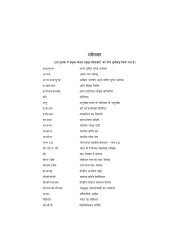
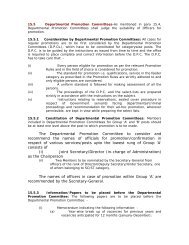
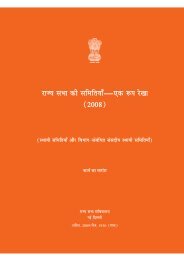
![jkT; lHkk% fodkl] 'kfDr;ka vkSj fLFkfr](https://img.yumpu.com/48829500/1/184x260/jkt-lhkk-fodkl-kfdrka-vksj-flfkfr.jpg?quality=85)

